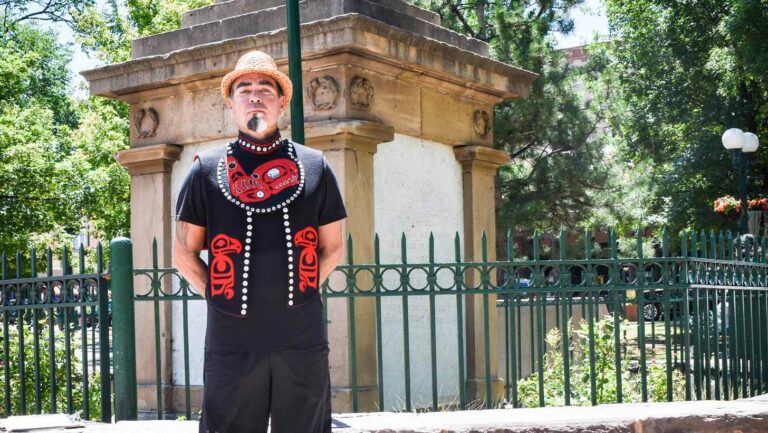The Santa Fe Plaza on a Sunday in July is a snarl of oblivious pedestrians, stoic vendors and competing melodies from a handful of acoustic ensembles bringing their own version of the sound of Santa Fe to assembled tourists. In the middle of the plaza sits an obelisk dedicated in 1868 to, among others, “the heroes who have fallen in the various battles with the Indians in the territory of New Mexico.” Standing next to the monument wearing boots that seem way too warm for the weather is Da-ka-xeen Mehner, an artist intent on pointing out another side of the story this monument proclaims. An Alaska native, Mehner is in Santa Fe for a 10-day residency to further social engagement around contemporary native issues. His project is to indigenize several monuments in and around Santa Fe, bringing a perspective on the shared history of these spaces not acknowledged by the monuments themselves. Using social media, Mehner has invited people to be photographed at the monuments with him to build composite images of the monuments that include people who can speak to the other stories of these spaces. The process has generated new conversations about the purpose of the monuments themselves and a reevaluation of the perspective on history that they represent. Weekly Alibi caught up with Mehner while he was photographing Sunday afternoon at the Obelisk in Santa Fe Plaza to talk about his work and the histories that monuments like this represent. The following is an edited version of that conversation. Weekly Alibi: Tell me about your project.Da-ka-xeen Mehner: I am doing a residency at the IAIA (Institute of American Indian Arts) Museum of Contemporary Native Arts. It’s funded through the Andy Warhol Foundation and it’s for public engagement. The project is really about engaging people in public spaces and bringing awareness to the artwork that is represented within those public spaces. Are you indigenizing or re-indigenizing these spaces?That’s a great question. Originally, I was thinking of indigenizing the spaces, but re-indigenizing is probably more correct. The space was an indigenous space.You are primarily a sculptor. Why did you choose to work in the medium of photography for this project?It was the speed. It was something I could conceivably do within a 10-day period. It also bounces off a project I did in Anchorage with the Captain Cook Monument. It is an extension of that and also looks at public spaces. If a public space is for everyone, is there equal representation within that space? Santa Fe Plaza itself is a made-up place. It is a myth unto itself. When you re-indigenize this space, are you dispelling that myth or augmenting it?I would say augmenting, adding or really trying to create an awareness that there are multiple histories being told in every space. Any one monument does not tell a whole story. I would like to add to that story for the brief time that I am here.Is the artwork the process, the event or the finished product?As a maker, I always like to have some sort of finished product at the end, but I really do feel like the artwork is in part visiting with people, asking if they know the history of the monument and having that conversation as they come through. But as a maker, I do always want to have something at the end.Otherwise it would just be a flash mob.Right.I know that you have been out to the Oñate monument as part of this project. How would you relate the character of Captain Cook to that of Don Juan de Oñate? I think it is similar in that these are monuments to discoverers and conquerors. Really, disenfranchising the history that was here. With Captain Cook, he is credited with discovering Alaska, but as an indigenous person, we know we were here. We didn’t have to get discovered. It is really just reexamining how history is told and trying to insert my history a little bit into each place. There has been a lot of focus recently across the country on monuments to less-than-admirable people. What do you think we should do with monuments like that?It’s a difficult situation. I just had a conversation with a couple that was from the South about the Confederate monuments there. Some of them have been taken down and some of them have been renamed. Do we erase a history or do we add to this complex history that we all share in? If it was up to me, we would put an indigenous monument right next to the other one at every spot so that we could see the other history. Maybe not an indigenous one, but a telling of the other histories that aren’t represented at each of these spaces so that you can have that multiplicity of history in that space.That would be a lot of monuments. You would have a lot of artists employed then.
The Monuments IAIA MoCNA Social Engagement Project by Da-ka-xeen Mehner
See the final project at da-ka-xeen.com










